+ Open data
Open data
- Basic information
Basic information
| Entry | Database: PDB / ID: 1pq1 | ||||||
|---|---|---|---|---|---|---|---|
| Title | Crystal structure of Bcl-xl/Bim | ||||||
 Components Components |
| ||||||
 Keywords Keywords | APOPTOSIS / Bcl-xl/Bim | ||||||
| Function / homology |  Function and homology information Function and homology informationActivation of BIM and translocation to mitochondria / The NLRP1 inflammasome / leukocyte homeostasis / BH3-only proteins associate with and inactivate anti-apoptotic BCL-2 members / positive regulation of lymphocyte apoptotic process / NRAGE signals death through JNK / lymphocyte homeostasis / regulation of developmental pigmentation / RAS processing / lymphocyte apoptotic process ...Activation of BIM and translocation to mitochondria / The NLRP1 inflammasome / leukocyte homeostasis / BH3-only proteins associate with and inactivate anti-apoptotic BCL-2 members / positive regulation of lymphocyte apoptotic process / NRAGE signals death through JNK / lymphocyte homeostasis / regulation of developmental pigmentation / RAS processing / lymphocyte apoptotic process / positive regulation of mitochondrial membrane permeability involved in apoptotic process / developmental pigmentation / positive regulation of fibroblast apoptotic process / apoptotic process involved in embryonic digit morphogenesis / apoptotic process in bone marrow cell / dendritic cell apoptotic process / ear development / dendritic cell proliferation / positive regulation of mononuclear cell proliferation / T cell apoptotic process / negative regulation of dendritic cell apoptotic process / negative regulation of intrinsic apoptotic signaling pathway in response to DNA damage / positive regulation of T cell apoptotic process / regulation of organ growth / tube formation / mammary gland development / negative regulation of mitochondrial outer membrane permeabilization involved in apoptotic signaling pathway / negative regulation of execution phase of apoptosis / regulation of mitochondrial membrane permeability / fertilization / regulation of growth / Bcl-2 family protein complex / myeloid cell homeostasis / response to cycloheximide / thymocyte apoptotic process / hepatocyte apoptotic process / cellular response to alkaloid / negative regulation of release of cytochrome c from mitochondria / odontogenesis of dentin-containing tooth / positive regulation of release of cytochrome c from mitochondria / negative regulation of reproductive process / negative regulation of developmental process / germ cell development / dynein complex binding / BH3 domain binding / T cell homeostasis / B cell homeostasis / ectopic germ cell programmed cell death / negative regulation of protein localization to plasma membrane / negative regulation of extrinsic apoptotic signaling pathway via death domain receptors / negative regulation of endoplasmic reticulum stress-induced intrinsic apoptotic signaling pathway / ovarian follicle development / spleen development / positive regulation of cell cycle / response to cytokine / extrinsic apoptotic signaling pathway in absence of ligand / response to endoplasmic reticulum stress / release of cytochrome c from mitochondria / thymus development / cell-matrix adhesion / epithelial cell proliferation / regulation of cytokinesis / regulation of mitochondrial membrane potential / post-embryonic development / mitochondrion organization / cellular response to amino acid stimulus / symbiont-mediated activation of host apoptosis / kidney development / positive regulation of protein-containing complex assembly / cellular response to gamma radiation / response to radiation / mitochondrial membrane / response to virus / male gonad development / intrinsic apoptotic signaling pathway in response to DNA damage / synaptic vesicle membrane / positive regulation of neuron apoptotic process / neuron apoptotic process / spermatogenesis / nuclear membrane / regulation of apoptotic process / microtubule binding / defense response to virus / in utero embryonic development / negative regulation of neuron apoptotic process / mitochondrial outer membrane / mitochondrial inner membrane / positive regulation of apoptotic process / mitochondrial matrix / intracellular membrane-bounded organelle / apoptotic process / centrosome / protein kinase binding / negative regulation of apoptotic process / endoplasmic reticulum / mitochondrion / identical protein binding / membrane / cytoplasm / cytosol Similarity search - Function | ||||||
| Biological species |  | ||||||
| Method |  X-RAY DIFFRACTION / X-RAY DIFFRACTION /  MOLECULAR REPLACEMENT / Resolution: 1.65 Å MOLECULAR REPLACEMENT / Resolution: 1.65 Å | ||||||
 Authors Authors | Liu, X. / Dai, S. / Zhu, Y. / Marrack, P. / Kappler, J.W. | ||||||
 Citation Citation |  Journal: Immunity / Year: 2003 Journal: Immunity / Year: 2003Title: The structure of a Bcl-xl/Bim fragment complex: Implications for Bim function Authors: Liu, X. / Dai, S. / Zhu, Y. / Marrack, P. / Kappler, J.W. | ||||||
| History |
|
- Structure visualization
Structure visualization
| Structure viewer | Molecule:  Molmil Molmil Jmol/JSmol Jmol/JSmol |
|---|
- Downloads & links
Downloads & links
- Download
Download
| PDBx/mmCIF format |  1pq1.cif.gz 1pq1.cif.gz | 53.5 KB | Display |  PDBx/mmCIF format PDBx/mmCIF format |
|---|---|---|---|---|
| PDB format |  pdb1pq1.ent.gz pdb1pq1.ent.gz | 37.1 KB | Display |  PDB format PDB format |
| PDBx/mmJSON format |  1pq1.json.gz 1pq1.json.gz | Tree view |  PDBx/mmJSON format PDBx/mmJSON format | |
| Others |  Other downloads Other downloads |
-Validation report
| Summary document |  1pq1_validation.pdf.gz 1pq1_validation.pdf.gz | 436.4 KB | Display |  wwPDB validaton report wwPDB validaton report |
|---|---|---|---|---|
| Full document |  1pq1_full_validation.pdf.gz 1pq1_full_validation.pdf.gz | 442.6 KB | Display | |
| Data in XML |  1pq1_validation.xml.gz 1pq1_validation.xml.gz | 11.5 KB | Display | |
| Data in CIF |  1pq1_validation.cif.gz 1pq1_validation.cif.gz | 15.6 KB | Display | |
| Arichive directory |  https://data.pdbj.org/pub/pdb/validation_reports/pq/1pq1 https://data.pdbj.org/pub/pdb/validation_reports/pq/1pq1 ftp://data.pdbj.org/pub/pdb/validation_reports/pq/1pq1 ftp://data.pdbj.org/pub/pdb/validation_reports/pq/1pq1 | HTTPS FTP |
-Related structure data
| Related structure data |  1pq0SC S: Starting model for refinement C: citing same article ( |
|---|---|
| Similar structure data |
- Links
Links
- Assembly
Assembly
| Deposited unit | 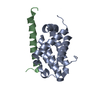
| ||||||||
|---|---|---|---|---|---|---|---|---|---|
| 1 |
| ||||||||
| Unit cell |
|
- Components
Components
| #1: Protein | Mass: 22056.209 Da / Num. of mol.: 1 / Fragment: BIM Source method: isolated from a genetically manipulated source Source: (gene. exp.)   Trichoplusia ni (cabbage looper) / Strain (production host): Hi-five / References: UniProt: Q64373 Trichoplusia ni (cabbage looper) / Strain (production host): Hi-five / References: UniProt: Q64373 |
|---|---|
| #2: Protein/peptide | Mass: 4120.569 Da / Num. of mol.: 1 Source method: isolated from a genetically manipulated source Source: (gene. exp.)   Trichoplusia ni (cabbage looper) / Strain (production host): Hi-five / References: UniProt: O54918 Trichoplusia ni (cabbage looper) / Strain (production host): Hi-five / References: UniProt: O54918 |
| #3: Water | ChemComp-HOH / |
-Experimental details
-Experiment
| Experiment | Method:  X-RAY DIFFRACTION / Number of used crystals: 1 X-RAY DIFFRACTION / Number of used crystals: 1 |
|---|
- Sample preparation
Sample preparation
| Crystal grow | Temperature: 298 K / Method: vapor diffusion, hanging drop / pH: 4.5 Details: NH4H2PO4, pH 4.5, VAPOR DIFFUSION, HANGING DROP, temperature 298K | ||||||||||||||||||||||||||||||
|---|---|---|---|---|---|---|---|---|---|---|---|---|---|---|---|---|---|---|---|---|---|---|---|---|---|---|---|---|---|---|---|
| Crystal grow | *PLUS pH: 6.5 / Method: vapor diffusion, hanging drop | ||||||||||||||||||||||||||||||
| Components of the solutions | *PLUS
|
-Data collection
| Diffraction | Mean temperature: 100 K |
|---|---|
| Diffraction source | Source:  ROTATING ANODE / Type: RIGAKU RU300 / Wavelength: 1.5418 Å ROTATING ANODE / Type: RIGAKU RU300 / Wavelength: 1.5418 Å |
| Detector | Type: RIGAKU RAXIS IV / Detector: IMAGE PLATE / Date: Feb 18, 2002 |
| Radiation | Monochromator: osmic mirrors / Protocol: SINGLE WAVELENGTH / Monochromatic (M) / Laue (L): M / Scattering type: x-ray |
| Radiation wavelength | Wavelength: 1.5418 Å / Relative weight: 1 |
| Reflection | Resolution: 1.65→20 Å / Num. all: 19877 / Num. obs: 19877 / % possible obs: 97.2 % / Observed criterion σ(F): 0 / Observed criterion σ(I): 0 / Redundancy: 4.8 % / Biso Wilson estimate: 25.1 Å2 / Rmerge(I) obs: 0.062 / Net I/σ(I): 8.6 |
| Reflection shell | Resolution: 1.65→1.75 Å / Redundancy: 4.4 % / Rmerge(I) obs: 0.218 / Mean I/σ(I) obs: 2.7 / Num. unique all: 1765 / % possible all: 90.9 |
| Reflection | *PLUS |
| Reflection shell | *PLUS % possible obs: 90.9 % / Num. unique obs: 1765 |
- Processing
Processing
| Software |
| |||||||||||||||||||||||||
|---|---|---|---|---|---|---|---|---|---|---|---|---|---|---|---|---|---|---|---|---|---|---|---|---|---|---|
| Refinement | Method to determine structure:  MOLECULAR REPLACEMENT MOLECULAR REPLACEMENTStarting model: mouse Bcl-xl, pdb entry 1PQ0 Resolution: 1.65→19.9 Å / Rfactor Rfree error: 0.008 / Isotropic thermal model: RESTRAINED / Cross valid method: THROUGHOUT / σ(F): 2 / Stereochemistry target values: Engh & Huber
| |||||||||||||||||||||||||
| Solvent computation | Solvent model: FLAT MODEL / Bsol: 47.2048 Å2 / ksol: 0.393725 e/Å3 | |||||||||||||||||||||||||
| Displacement parameters | Biso mean: 23.9 Å2
| |||||||||||||||||||||||||
| Refine analyze |
| |||||||||||||||||||||||||
| Refinement step | Cycle: LAST / Resolution: 1.65→19.9 Å
| |||||||||||||||||||||||||
| Refine LS restraints |
| |||||||||||||||||||||||||
| LS refinement shell | Resolution: 1.65→1.75 Å / Rfactor Rfree error: 0.026 / Total num. of bins used: 6
| |||||||||||||||||||||||||
| Xplor file |
| |||||||||||||||||||||||||
| Refinement | *PLUS Lowest resolution: 20 Å / Rfactor Rwork: 0.217 | |||||||||||||||||||||||||
| Solvent computation | *PLUS | |||||||||||||||||||||||||
| Displacement parameters | *PLUS | |||||||||||||||||||||||||
| Refine LS restraints | *PLUS
| |||||||||||||||||||||||||
| LS refinement shell | *PLUS Rfactor Rfree: 0.313 / Rfactor Rwork: 0.27 |
 Movie
Movie Controller
Controller



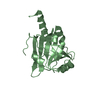
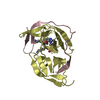
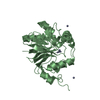
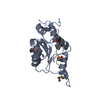
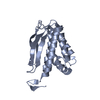
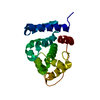

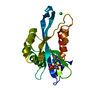
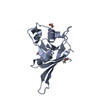

 PDBj
PDBj

